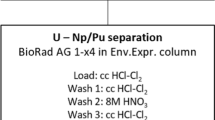Abstract
The determination of isotopic thorium by alpha spectrometric methods is a routine practice for bioassay and environmental measurement programs. Alpha-spectrometry has excellent detection limits (by mass) for all isotopes of thorium except 232Th due to its extremely long half-life. This paper discusses improvements in the detection limit and sensitivity over previously reported methods of pre-concentration neutron activation analysis (PCNAA) for the recovery corrected, isotopic determination of thorium in various matrices. Following irradiation, the samples weredissolved, 231Pa added as a tracer, and Pa isolated by two different methods and compared (extraction chromatography and anion exchange chromatography) followed by alpha spectrometry for recovery correction. Ion exchange chromatography was found to be superior for this application at this time, principally for reliability. The detection limit for 232Th of 3.5 · 10-7 Bq is almost three orders of magnitude lower than foralpha spectrometry using the PCRNAA method and one order of magnitude below previously reported PCNAA methods.
Similar content being viewed by others
References
M. E. Wrenn, N. P. Singh, N. Cohen, S. A. Ibrahim, G. Saccomanno, Thorium in Human Tissues, NUREG/CR-1227 US Nuclear Regulatory Commission, Washington, D.C., 1981.
Environmental Measurements Laboratory Procedures Manual: HASL-300, 27th ed., U.S. Dept. of Energy, New York, 1992.
K. Kitamura, Y. Inazawa, T. Morimoto, K. Sato, H. Higuchi, K. Imai, K. Watari, J. Radioanal. Nucl. Chem., 217 (1997) 175.
R. J. Clifton, M. Farrow, E. L. Hamilton, Ann. Occ. Hyg., 14 (1971) 303.
C. M. Sunta, H. S. Dang, D. D. Jaiswal, J. Radioanal. Nucl. Chem., 1 (1987) 149.
H. F. Lucas, Jr., D. N. Edgington, F. Markun, Health Phys., 19 (1970) 739.
D. N. Edgington, Intern. J. Appl. Radiation Isotopes, 18 (1967) 11.
M. Picer, P. Strohal, Anal. Chim. Acta, 40 (1968) 131.
D. D. Jaiswal, H. S. Dang, C. M. Sunta, J. Radioanal. Nucl. Chem., 88 (1985) 225.
S. E. Glover, R. H. Filby, S. B. Clark, J. Radioanal. Nucl. Chem., 234 (1998) 213.
H. G. Petrow, C. D. Strehlow, Anal. Chem., 39 (1967) 265.
J. S. Crain, L. L. Smith, J. S. Yaeger, J. A. Alvarodo, J. Radioanal. Nucl. Chem., 194 (1995) 133.
J. S. Crain, Spectroscopy, 11 (1996) 31.
J. S. Crain, B. L. Mikesell, Appl. Spectrosc., 46 (1992) 1498.
K. W. Terry, G. S. Hewson, G. Meuner, Health Phys., 68 (1995) 105.
S. E. Glover, R. H. Filby, S. B. Clark, J. Radioanal. Nucl. Chem., 234 (1998) 201.
Author information
Authors and Affiliations
Rights and permissions
About this article
Cite this article
Glover, S.E., Qu, H., LaMont, S.P. et al. Comparison of two ultra-sensitive methods for the determination of 232Thby recovery corrected pre-concentration radiochemicalneutron activation analysis. Journal of Radioanalytical and Nuclear Chemistry 248, 29–33 (2001). https://doi.org/10.1023/A:1010657503918
Issue Date:
DOI: https://doi.org/10.1023/A:1010657503918




